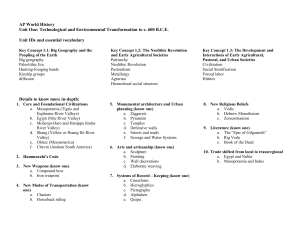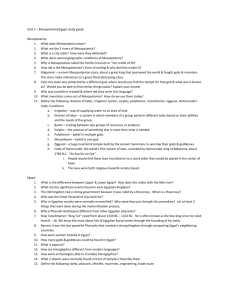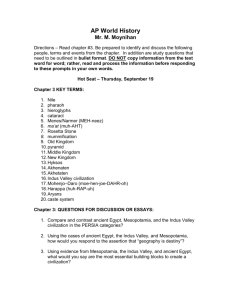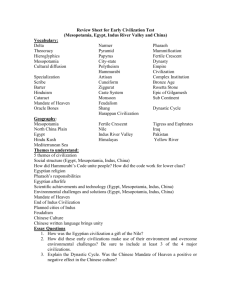Chapter 1 - Cloudfront.net
advertisement
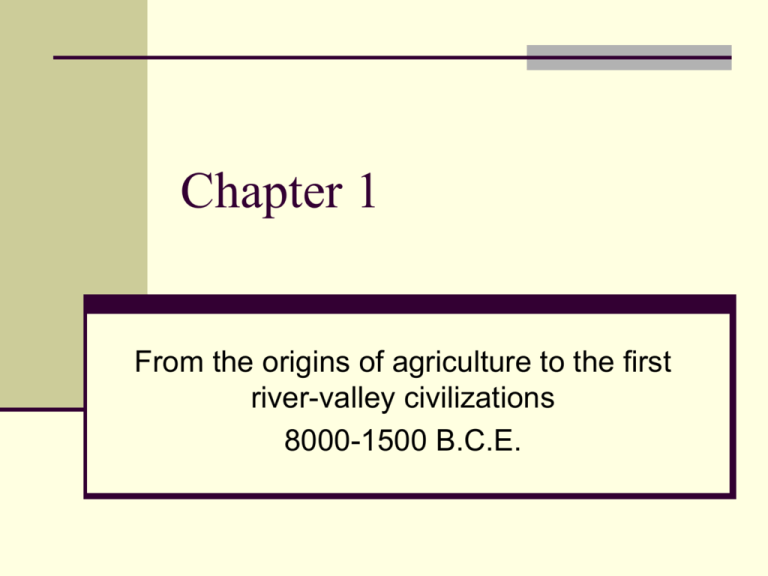
Chapter 1 From the origins of agriculture to the first river-valley civilizations 8000-1500 B.C.E. Before Civilization Human life before 8000 b.c.e. Exact date of first humans is debatable (6-8 million years ago) Humans=bipedalism (walking on 2 legs), opposable thumbs and a large brain. Paleolithic age (70,000 years ago to 8000 b.c.e.) Humans inhabited all the continents (except Antarctica) Survived by hunting and gathering Traveled in small groups (nomads) Did not develop a sense of property ownership No organized government structure Division of labor was based on sex Use of tools and weaving of cloth (26,000 years ago) Knowledge of natural environment (edible v. poisonous plants) Cave art and religion based on natural phenomena The Neolithic (agricultural) Revolution Refers to the changeover from food gathering to food producing that serves as a “marker” event to begin the foundations period. Not a single event, but a process (probably brought about food shortage due to climate changes) Middle east has earliest evidence of agriculture. Agriculture spread through cultural diffusion, but also rose as an independent invention. This revolution included the domestication of animals for food and work The Neolithic Revolution as a “Marker Event” Agriculture brought great change: People settled down Private property Division of Labor Social Inequality (landowners v. peasant) Gender Inequality-male superior physical strength gave them advantage. Women’s contribution was no longer central to the survival of the village. Importance of surplus Religious changes- from spirits to gods with human characteristics (polytheism) 3 craft industry emerged: pottery, metallurgy, & textiles Earliest Civilizations What are indicators of a civilization? Cities that serve as administrative centers A political system based on the control of a defined territory Highly specialized occupations Clear social class distinctions Long-distance trade Organized writing system Monumental buildings and major advances in science and the arts Cultural Hearths Areas where civilization first began that spread the ideas, innovations, and ideologies that culturally transformed the world. Mesopotamian cultural hearth Nile Valley cultural hearth Indus Valley cultural hearth East Asian cultural hearth Cultural hearths in the Americas: Olmec and Chavin Mesopotamia “Land between two rivers” Developed during 4th Millennium B.C.E. Writing developed by 3500 B.C.E. Governments by 3000B.C.E. Cities grew along the Tigris and Euphrates River Because of location in the Middle East it became a “crossroads” Two main groups settled here: Semites and Sumerians They built competing city-states that engaged in unceasing warfare Sumerians were the dominant group Mesopotamia: economic development Majority were farmers, herders, or workers directly associated with agriculture About 5% lived in cities and did not grow their own food People involved in trade…traded food Most people in cities were craft men, scribes (read/writing) or worked to ensure a reliable water source Many were slaves that did the worst jobs Mesopotamia: political development Before 2300 B.C.E. city states were theocracies (governed by gods or priests) Constant warfare gave the “warrior king” increased power A Semitic group led by Sargon the Great conquered the area and founded the Akkadian Empire Sargon and his descendents assumed responsibility for temples, city defenses, irrigation channels, and system of justice The Akkadian Empire lasted a little over a century Mesopotamia: political development After Akkadian Empire: 1700s B.C.E. Hammurabi led the Babylonians to conquer Mesopotamia 1500s B.C.E. Hittites conquered Mesopotamia 900s B.C.E. Assyrians conquered it 500s B.C.E. New Babylonians come to power Mesopotamia: political development Marker Event Hammurabi’s Code First known written law code Used by judges to punish crimes based on a standard set of rules Mesopotamia: Social Distinctions Hammurabi’s Code identified 3 distinct classes: Free land owners: royal family, priests, warriors, high gov. officials, merchants and some craftsmen and shopkeepers. Dependent farmers and craftsmen: worked for free a land owners Slaves: did domestic work and less desirable jobs. They were prisoners of war or debtors. They could win their freedom. Identified by haircut, which could be changed when freed. Mesopotamia: Social Distinctions Women lost social standing and freedom with the spread of agriculture: Food surplus made large families possible and tied women to the home. Women could own property, control their dowries, and participate in trade, but men control political and religious life. Their status decline over time. In later Mesopotamian history, men are allowed to take other wives. Mesopotamia: Cultural Characteristics “Marker Event” about 3500 B.C.E.: the Sumerian invention of writing. Earliest writing evolved from pictures of objects on clay cylinder seals to symbols and eventually into phonetic elements baked on clay tablets and written with a wedge-shaped stick-cuneiform. It was difficult to learn so scribes had power and status. Epic of Gilgamesh: story that explored human friendship, relations with gods, and meaning of life & death (included story of the great flood — continuity over time) Mesopotamia: Religious Beliefs Mesopotamians believed that gods interfered in human affairs and they must pleased the gods to survive. They were associated with forces of nature. Each city had its own principal god and a main temple at the center of city, usually zigguratsbrick pyramids with ramps and stairs. Priest had high standing and passed their positions/knowledge to their sons Priests preformed rituals, provided music, exorcised evil spirits, and interpreted dreams. Afterlife was full of suffering. Indus Valley Civilization Agriculture had developed by 5000 B.C.E. and villages and towns by 3000 B.C.E. in what is now Pakistan Its origin remains a mystery. The area around the Indus River was lush and fertile and was formed from water running from Himalayas and Hindu Kush Mountains provided some protection from invasion, but passes where discovered early by Aryans. Harappa Mohenjo-Daro Indus Valley Civilization: Economic Characteristics Advanced agricultural system Many animals were domesticated Abundant crops allowed job specialization in the cities. Craftsmen appear to have been inferior to those in Egypt and Mesopotamia. 2 large cities have been discovered – Mohenjo-Daro and Harappa. They were centers of trade with China, Southeast Asia, southern India, Afghanistan and Mesopotamia. Indus Valley Civilization: Political Development Very little is known about the political system: Construction of cities suggest a well-organized government Streets, fortifications, large granaries and sewage system were probably controlled by governments. Indus Valley Civilization: Society & Culture Evidence (size and sophistication of dwellings) suggest that there were clear social classes. Little is known about its religion. They had a number of gods and goddesses. Few artistic evidence: few fertility figurines They had a writing system found in seals, but archeologists have had little success in deciphering them. Decline of Indus Valley Civilization Indus valley cities were abandoned around 1900 B.C.E. (reasons are uncertain). Decline is gradual, with Mohenjo-Daro abandoned around 1200 B.C.E. and Harappa somewhat later. Theories: Systems failure: breakdown of econ., political and social systems Earthquake, flood, or ecological changes Large population put stress on environment
